Sentinel-2 Reveals Record-Breaking Po River Shrinking Due to Severe Drought in 2022
Abstract
1. Introduction
2. Materials and Methods
2.1. Study Area
2.2. Discharge Analysis
2.3. Remote Sensing Data Processing
3. Results
3.1. River Discharge
3.2. Changes in Monthly Water Frequency
4. Discussion
4.1. Proposed Methodological Approach
4.2. Applicability of the Proposed Methodology: Po River Shrinking in Summer 2022
4.3. Lessons Learned and Future Perspectives
5. Conclusions
Author Contributions
Funding
Data Availability Statement
Acknowledgments
Conflicts of Interest
References
- Belletti, B.; Rinaldi, M.; Bussettini, M.; Comiti, F.; Gurnell, A.M.; Mao, L.; Nardi, L.; Vezza, P. Characterising Physical Habitats and Fluvial Hydromorphology: A New System for the Survey and Classification of River Geomorphic Units. Geomorphology 2017, 283, 143–157. [Google Scholar] [CrossRef]
- Pizzarro, A.; Gran, D.V.; Navarrete Muñoz, E.M.; Dal Sasso, S.F. The Use of Unmanned Aerial Systems for River Monitoring: A Bibliometric Analysis Covering the Last 25 Years. Hydrology 2024, 11, 80. [Google Scholar] [CrossRef]
- Koutalakis, P.; Tzoraki, O.; Zaimes, G.N. Detecting riverbank changes with remote sensing tools. Case study: Aggitis River in Greece. Ann. Dunarea De Jos Univ. Galati. Fascicle II Math. Phys. Theor. Mech. 2019, 42, 134–142. [Google Scholar] [CrossRef]
- Brenna, A.; Bizzi, S.; Surian, N. How Multiple Anthropic Pressures May Lead to Unplanned Channel Patterns: Insights from the Evolutionary Trajectory of the Po River (Italy). Catena 2024, 234, 107598. [Google Scholar] [CrossRef]
- Floury, M.; Delattre, C.; Ormerod, S.J.; Souchon, Y. Global versus local change effects on a large European river. Sci. Total Environ. 2012, 441, 220–229. [Google Scholar] [CrossRef]
- Kiss, T.; Blancka, V. River channel response to climate- and human-induced hydrological changes: Case study on the meandering Hernád River, Hungary. Geomorphology 2012, 175–176, 115–125. [Google Scholar] [CrossRef]
- Jakovljević, G.; Govedarica, M.; Álvarez-Taboada, F. Waterbody mapping: A comparison of remotely sensed and GIS open data sources. Int. J. Remote Sens. 2018, 40, 2936–2964. [Google Scholar] [CrossRef]
- Malahlela, O.E. Inland waterbody mapping: Towards improving discrimination and extraction of inland surface water features. Int. J. Remote Sens. 2016, 37, 4574–4589. [Google Scholar] [CrossRef]
- Colombo, N.; Guyennon, N.; Valt, M.; Salerno, F.; Godone, D.; Cianfarra, P.; Freppaz, M.; Maugeri, M.; Manara, V.; Acquaotta, F.; et al. Unprecedented Snow-Drought Conditions in the Italian Alps during the Early 2020s. Environ. Res. Lett. 2023, 18, 074014. [Google Scholar] [CrossRef]
- Yang, X.; Qin, Q.; Yésou, H.; Ledauphin, T.; Koehl, M.; Grussenmeyer, P.; Zhu, Z. Monthly Estimation of the Surface Water Extent in France at a 10-m Resolution Using Sentinel-2 Data. Remote Sens. Environ. 2020, 244, 111803. [Google Scholar] [CrossRef]
- Rinaldi, M.; Belletti, B.; Bussettini, M.; Comiti, F.; Golfieri, B.; Lastoria, B.; Marchese, E.; Nardi, L.; Surian, N. New Tools for the Hydromorphological Assessment and Monitoring of European Streams. J. Environ. Manag. 2017, 202, 363–378. [Google Scholar] [CrossRef] [PubMed]
- Bhaga, T.D.; Dube, T.; Shekede, M.D.; Shoko, C. Investigating the effectiveness of Landsat-8 OLI and Sentinel-2 MSI satellite data in monitoring the effects of drought on surface water resources in the Western Cape Province, South Africa. Remote Sens. Appl. Soc. Environ. 2023, 32, 101037. [Google Scholar] [CrossRef]
- Directive 2000/60/EC of the European Parliament and of the Council of 23 October 2000 Establishing a Framework for Community Action in the Field of Water Policy. 2000. Available online: https://eur-lex.europa.eu/legal-content/EN/TXT/HTML/?uri=CELEX:32000L0060 (accessed on 12 March 2025).
- Belletti, B.; Rinaldi, M.; Buijse, A.D.; Gurnell, A.M.; Mosselman, E. A Review of Assessment Methods for River Hydromorphology. Environ. Earth Sci. 2014, 73, 2079–2100. [Google Scholar] [CrossRef]
- Carbonneau, P.E.; Bizzi, S. Global mapping of river sediment bars. Earth Surf. Process. Landf. 2024, 49, 15–23. [Google Scholar] [CrossRef]
- Manfreda, S.; Saddi, K.C.; Miglino, D.; Jomaa, S.; Eltner, A.; Perks, M.; Peña-Haro, S.; Bogaard, T.; Van Emmerik, T.H.M.; Mariani, S.; et al. Advancing River Monitoring Using Image-Based Techniques: Challenges and Opportunities. Hydrol. Sci. J. 2024, 69, 657–677. [Google Scholar] [CrossRef]
- Mariani, S.; Bussettini, M. I Dati Sentinel per Monitorare i Corsi d’acqua. Ecoscienza 2021, 5, 28–30. (In Italian) [Google Scholar]
- Rinaldi, M.; Surian, N.; Comiti, F.; Bussettini, M. A Method for the Assessment and Analysis of the Hydromorphological Condition of Italianan Streams: The Morphological Quality Index. Geomorphology 2013, 180–181, 96–108. [Google Scholar] [CrossRef]
- Pekel, J.-F.; Cottam, A.; Gorelick, N.; Belward, A.S. High-resolution mapping of global surface water and its long-term changes. Nature 2016, 540, 418–422. [Google Scholar] [CrossRef]
- Souza, C.; Kirchhoff, F.; Oliveira, B.; Ribeiro, J.; Sales, M. Long-term annual surface water change in the Brazilian Amazon biome: Potential links with deforestation, infrastructure development and climate change. Water 2019, 11, 566. [Google Scholar] [CrossRef]
- Cordeiro, M.C.; Martinez, J.M.; Peña-Luque, S. Automatic water detection from multidimensional hierarchical clustering for Sentinel-2 images and a comparison with Level 2A processors. Remote Sens. Environ. 2021, 253, 112209. [Google Scholar] [CrossRef]
- Yousefi, P.; Jalab, H.A.; Ibrahim, R.W.; Noor, N.F.M.; Ayub, M.N.; Gani, A. Waterbody segmentation in satellite imagery applying modified kernel kmeans. Malays. J. Comput. Sci. 2018, 31, 143–154. [Google Scholar] [CrossRef]
- Karaman, M. Comparison of thresholding methods for shoreline extraction from Sentinel-2 and Landsat-8 imagery: Extreme Lake Salda, track of Mars on Earth. J. Environ. Manag. 2021, 298, 113481. [Google Scholar] [CrossRef] [PubMed]
- Kaplan, G.; Avdan, U. Object-based water body extraction model using Sentinel-2 satellite imagery. Eur. J. Remote Sens. 2017, 50, 137–143. [Google Scholar] [CrossRef]
- Valentini, E.; Taramelli, A.; Filipponi, F.; Giulio, S. An effective procedure for EUNIS and Natura 2000 habitat type mapping in estuarine ecosystems integrating ecological knowledge and remote sensing analysis. Ocean Coast. Manag. 2015, 108, 52–64. [Google Scholar] [CrossRef]
- Wieland, M.; Martinis, S. A modular processing chain for automated flood monitoring from multi-spectral satellite data. Remote Sens. 2019, 11, 2330. [Google Scholar] [CrossRef]
- Acharya, T.D.; Lee, D.H.; Yang, I.T.; Lee, J.K. Identification of water bodies in a Landsat 8 OLI image using a J48 decision tree. Sensors 2016, 16, 1075. [Google Scholar] [CrossRef]
- Nandi, I.; Srivastava, P.K.; Shah, K. Floodplain mapping through support vector machine and optical/infrared images from Landsat 8 OLI/TIRS sensors: Case study from Varanasi. Water Resour. Manag. 2017, 31, 1157–1171. [Google Scholar] [CrossRef]
- Jiang, Z.; Wen, Y.; Zhang, G.; Wu, X. Water Information Extraction Based on Multi-Model RF Algorithm and Sentinel-2 Image Data. Sustainability 2022, 14, 3797. [Google Scholar] [CrossRef]
- Mishra, K.; Prasad, P.R.C. Automatic extraction of water bodies from Landsat imagery using perceptron model. J. Computat. Environ. Sci. 2015, 2015, 903465. [Google Scholar] [CrossRef]
- Wang, X.; Xie, S.; Zhang, X.; Chen, C.; Guo, H.; Du, J.; Duan, Z. A robust multiband water index (MBWI) for automated extraction of surface water from Landsat 8 OLI imagery. Int. J. Appl. Earth Obs. Geoinf. 2018, 68, 73–91. [Google Scholar] [CrossRef]
- Bangira, T.; Alfieri, S.M.; Menenti, M.; van Niekerk, A. Comparing thresholding with machine learning classifiers for mapping complex water. Remote Sens. 2019, 11, 1351. [Google Scholar] [CrossRef]
- Valman, S.J.; Boyd, D.S.; Carbonneau, P.E.; Johnson, M.F.; Dugdale, S.J. An AI Approach to Operationalise Global Daily PlanetScope Satellite Imagery for River Water Masking. Remote Sens. Environ. 2024, 301, 113932. [Google Scholar] [CrossRef]
- Formetta, G.; Tootle, G.; Therrell, M. Regional Reconstruction of Po River Basin (Italy) Streamflow. Hydrology 2022, 9, 163. [Google Scholar] [CrossRef]
- Montanari, A. Hydrology of the Po River: Looking for changing patterns in river discharge. Hydrology Earth Syst. Sci. 2012, 16, 3739–3747. [Google Scholar] [CrossRef]
- Zanchettin, D.; Traverso, P.; Tomasino, M. Po River discharges: A preliminary analysis of a 200-year time series. Clim. Change 2008, 89, 411–433. [Google Scholar] [CrossRef]
- Vezzoli, R.; Mercogliano, P.; Pecora, S.; Zollo, A.L.; Cacciamani, C. Hydrological simulation of Po River (North Italy) discharge under climate change scenarios using the RCM COSMO-CLM. Sci. Total Environ. 2015, 521–522, 346–358. [Google Scholar] [CrossRef]
- Bozzola, M.; Swanson, T. Policy implications of climate variability on agriculture: Water management in the Po river basin, Italy. Environ. Sci. Policy 2014, 43, 26–38. [Google Scholar] [CrossRef]
- Coppola, E.; Verdecchia, M.; Giorgi, F.; Colaiuda, V.; Tomassetti, B.; Lombardi, A. Changing hydrological conditions in the Po basin under global warming. Sci. Total Environ. 2014, 493, 1183–1196. [Google Scholar] [CrossRef]
- Simeoni, U.; Corbau, C. A review of the Delta Po evolution (Italy) related to climatic changes and human impacts. Geomorphology 2009, 107, 64–71. [Google Scholar] [CrossRef]
- Barca, G.; Mariani, S.; Lastoria, B.; Piva, F.; Archi, F.; Botto, A.; Casaioli, M.; Forte, T.; Marchetti, G.; Peruzzi, C.; et al. Bilancio Idrologico Nazionale: Focus Su Siccità e Disponibilità Naturale Della Risorsa Idrica Rinnovabile. Aggiornamento al 2022. Ist. Super. Per La Prot. E La Ric. Ambient. 2023, 388, 22. Available online: https://www.isprambiente.gov.it/files2023/pubblicazioni/rapporti/rapporto_388_2023_siccita_2022.pdf (accessed on 12 March 2025). (In Italian).
- Montanari, A.; Nguyen, H.; Rubinetti, S.; Ceola, S.; Galelli, S.; Rubino, A.; Zanchettin, D. Why the 2022 Po River Drought Is the Worst in the Past two Centuries. Environ. Stud. 2023, 9, eadg8304. [Google Scholar] [CrossRef] [PubMed]
- Dokić, M.; Stričević, L.; Gocić, M.; Golubović, N.; Mileti, M. Analysis of discharge fluctuation using modified Streamflow Drought Index (SDI) and Standardized Precipitation Index (SPI) in the upper Nišava River Basin. Serbian J. Geosci. 2023, 8, 15–26. [Google Scholar] [CrossRef]
- Cancelliere, A.; Di Mauro, G.; Bonaccorso, B.; Rossi, G. Drought forecasting using the Standardized Precipitation Index. Water Resour Manag. 2007, 21, 801–819. [Google Scholar] [CrossRef]
- Mcfeeters, S.K. The use of the Normalized Difference Water Index (NDWI) in the delineation of open water features. International. J. Remote Sens. 1996, 17, 1425–1432. [Google Scholar] [CrossRef]
- Filipponi, F. Improve Sentinel-2 time series consistency with S2SDB DataBase for operational image co-registration. Trends Earth Obs. Earth Obs. Curr. Chall. Oppor. Environ. Monit. 2024, 3, 162–166. Available online: https://aitonline.org/wp-content/uploads/2024/11/EarthObservation_current_challenges_opportunities_environmental_monitoring.pdf (accessed on 12 March 2025). [CrossRef]
- Scheffler, D.; Hollstein, A.; Diedrich, H.; Segl, K.; Hostert, P. AROSICS: An Automated and Robust Open-Source Image Co-Registration Software for Multi-Sensor Satellite Data. Remote Sens. 2017, 9, 676. [Google Scholar] [CrossRef]
- Filipponi, F.; Smiraglia, D.; Agrillo, E. Earth Observation for Phenological Metrics (EO4PM): Temporal Discriminant to Characterize Forest Ecosystems. Remote Sens. 2022, 14, 721. [Google Scholar] [CrossRef]
- ARPAE. Annali Idrologici. Agenzia Regionale Prevenzione e Ambiente Emilia Romagna. 2024. Available online: https://www.arpae.it/it/temi-ambientali/meteo/report-meteo/annali-idrologici (accessed on 11 September 2024). (In Italian)
- Sekertekin, A.; Cicekli, S.Y.; Arslan, N. Index-based identification of surface water resources using Sentinel-2 satellite imagery. In Proceedings of the 2nd International Symposium on Multidisciplinary Studies and Innovative Technologies (ISMSIT), Ankara, Turkey, 19–21 October 2018; IEEE: New York, NY, USA, 2018; pp. 1–5. [Google Scholar] [CrossRef]
- Boschetti, M.; Nutini, F.; Manfron, G.; Brivio, P.A.; Nelson, A. Comparative analysis of normalised difference spectral indices derived from MODIS for detecting surface water in flooded rice cropping systems. PLoS ONE 2014, 9, e88741. [Google Scholar] [CrossRef]
- Ji, L.; Zhang, L.; Wylie, B. Analysis of dynamic thresholds for the normalized difference water index. Photogramm. Eng. Remote Sens. 2009, 75, 1307–1317. [Google Scholar] [CrossRef]
- Perfilieva, I.; Novák, V.; Dvořák, A. Fuzzy transform in the analysis of data. Int. J. Approx. Reason. 2008, 48, 36–46. [Google Scholar] [CrossRef]
- Montanari, A.; Young, G.; Savenije, H.H.G.; Hughes, D.; Wagener, T.; Ren, L.L.; Koutsoyiannis, D.; Cudennec, C.; Toth, E.; Grimaldi, S.; et al. “Panta Rhei—Everything Flows”: Change in hydrology and society—The IAHS Scientific Decade 2013–2022. Hydrollogy Sci. J. 2013, 58, 1256–1275. [Google Scholar] [CrossRef]
- García, M.; Alcayaga, H.; Pizarro, A. Automatic Segmentation of Water Bodies Using RGB Data: A Physically Based Approach. Remote Sens. 2023, 15, 1170. [Google Scholar] [CrossRef]
- Zheng, Y.; Tang, L.; Wang, H. An improved approach for monitoring urban built-up areas by combining NPP-VIIRS nighttime light, NDVI, NDWI, and NDBI. J. Clean. Prod. 2021, 328, 129488. [Google Scholar] [CrossRef]
- Du, Y.; Zhang, Y.; Ling, F.; Wang, Q.; Li, W.; Li, X. Water Bodies’ Mapping from Sentinel-2 Imagery with Modified Normalized Difference Water Index at 10-m Spatial Resolution Produced by Sharpening the SWIR Band. Remote Sens. 2016, 8, 354. [Google Scholar] [CrossRef]
- Bizzi, S.; Demarchi, L.; Grabowsky, R.C.; Weissteiner, C.J.; Van de Bund, W. The use of remote sensing to characterise hydromorphological properties of European rivers. Aquat. Sci. 2016, 78, 57–70. [Google Scholar] [CrossRef]
- Carbonneau, P.E.; Belletti, B.; Micotti, M.; Lastoria, B.; Casaioli, M.; Mariani, S.; Marchetti, G.; Bizzi, S. UAV-based training for fully fuzzy classification of Sentinel-2 fluvial scenes. Earth Surf. Process. Landf. 2020, 45, 3120–3140. [Google Scholar] [CrossRef]
- Cornebise, J.; Oršolić, I.; Kalaitzis, F. Open high-resolution satellite imagery: The WorldStrat dataset–with application to super-resolution. Adv. Neural Inf. Proces. Syst. 2022, 35, 25979–25991. [Google Scholar] [CrossRef]
- Fryirs, K.; Brierley, G. Assemblages of geomorphic units: A building block approach to analysis and interpretation of river character, behaviour, condition and recovery. Earth Surf. Process. Landf. 2022, 47, 92–108. [Google Scholar] [CrossRef]
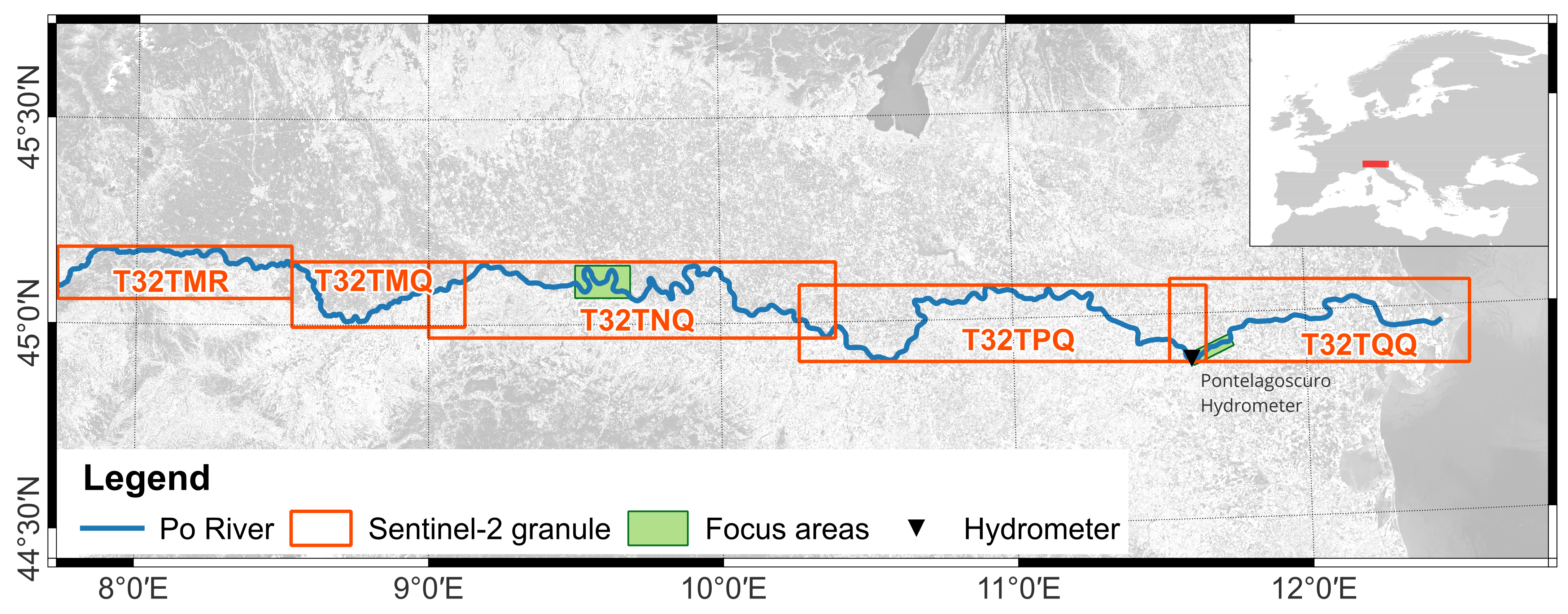
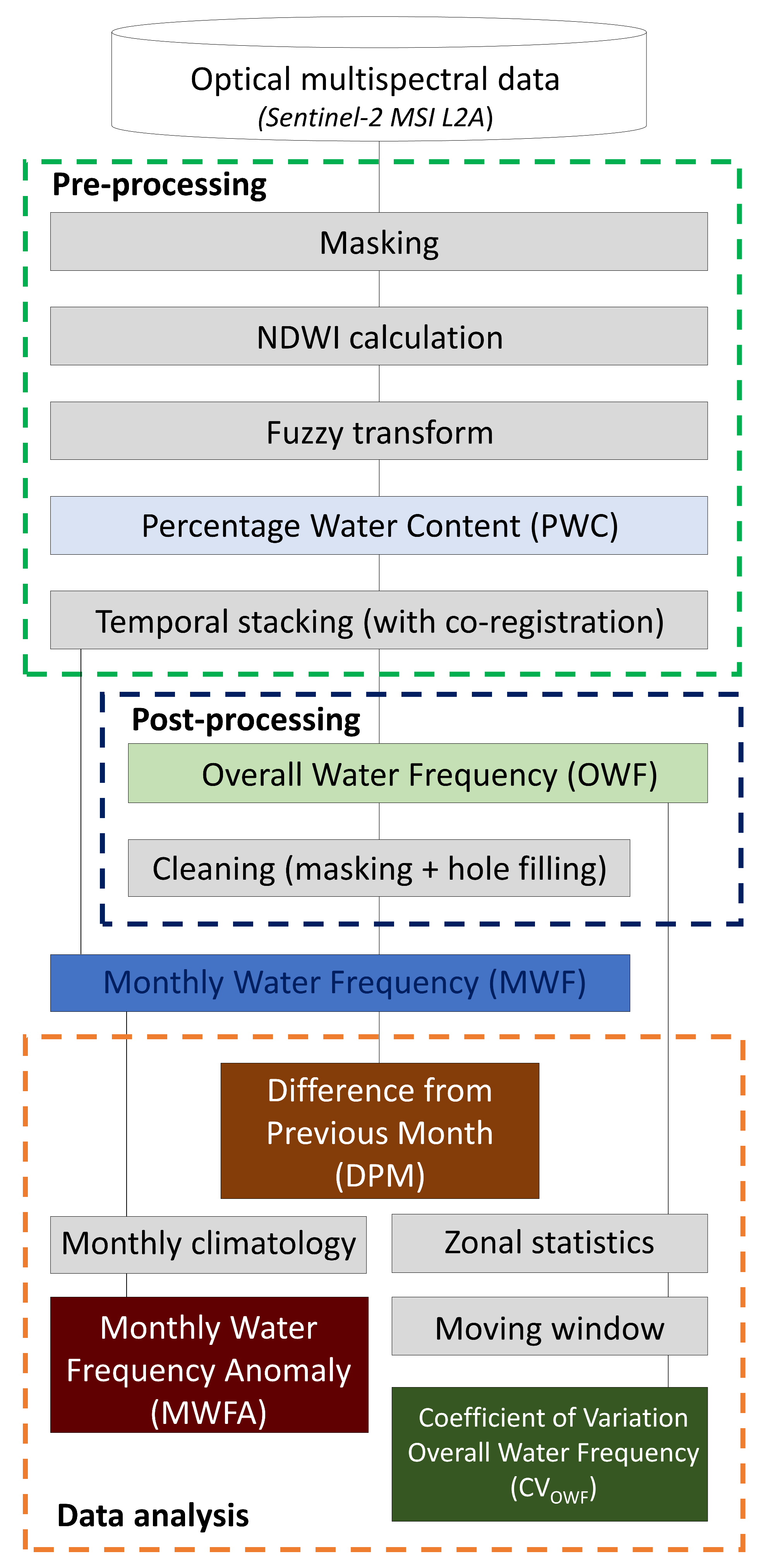
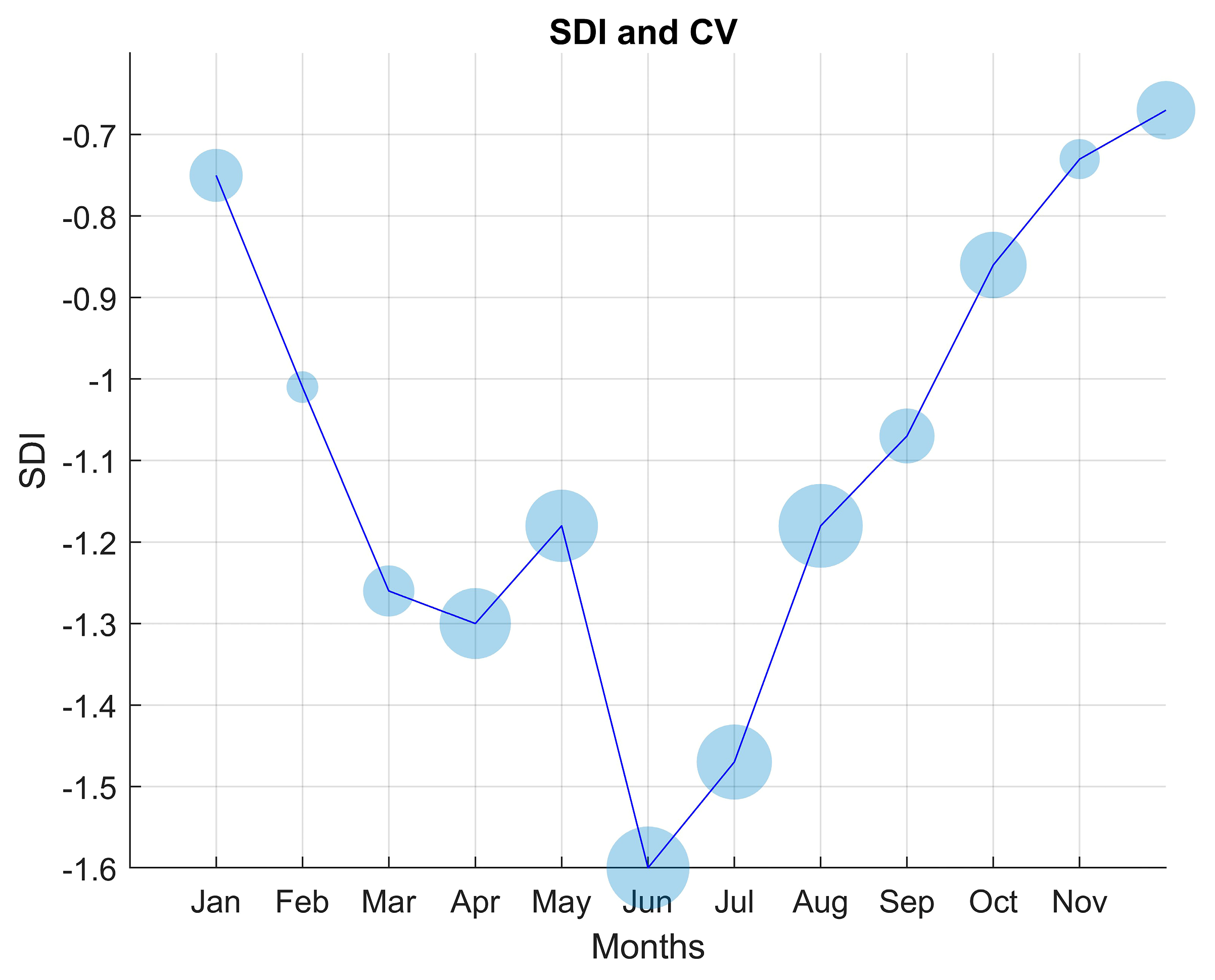
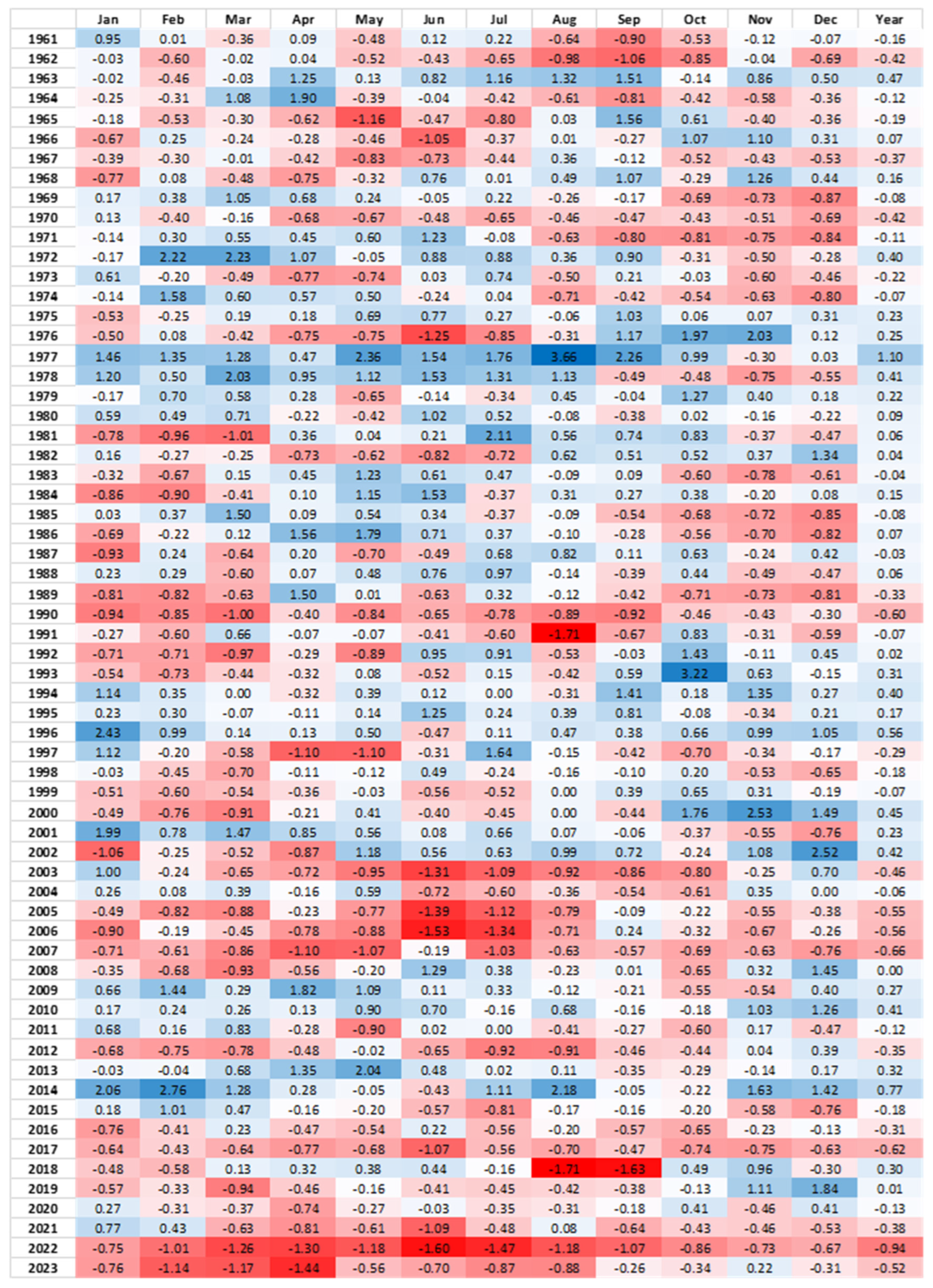

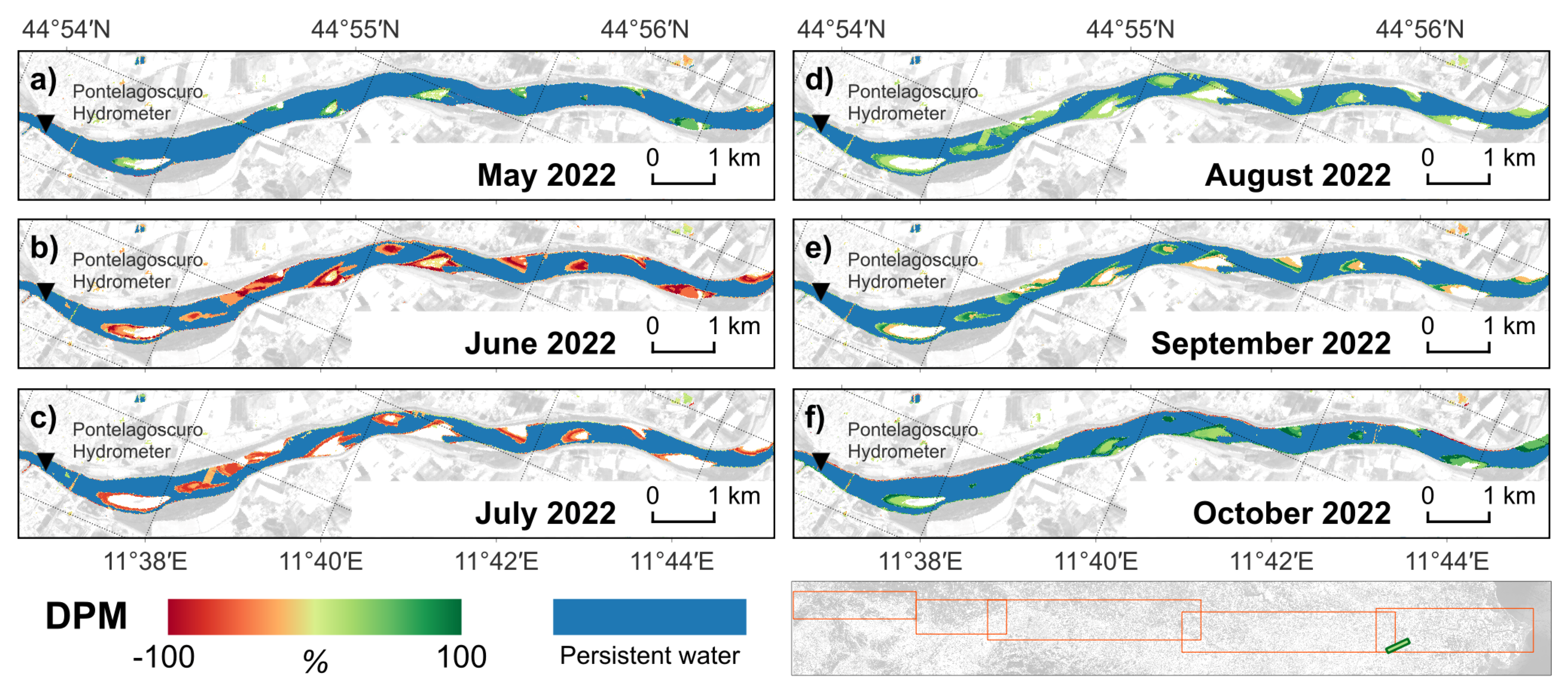


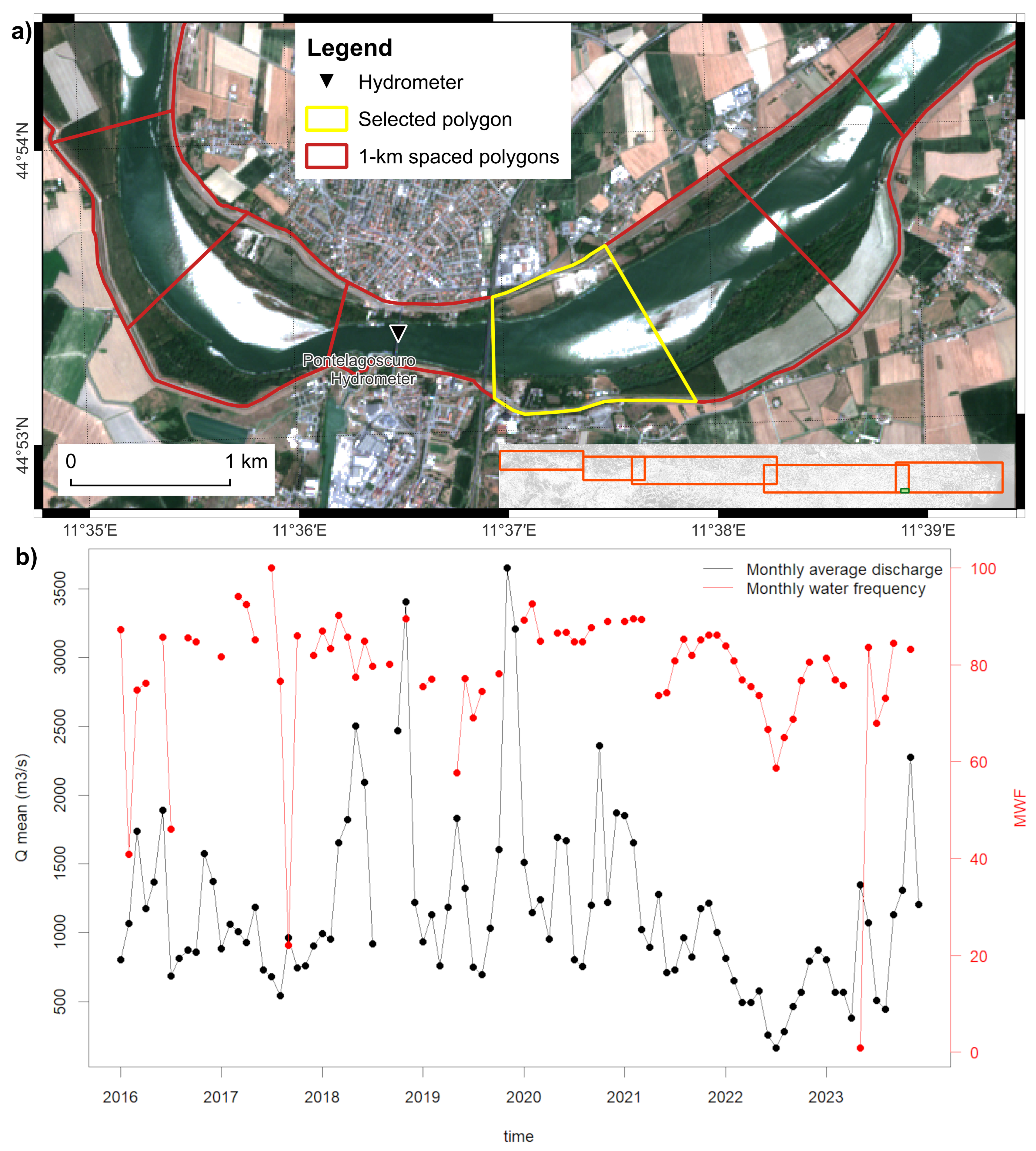
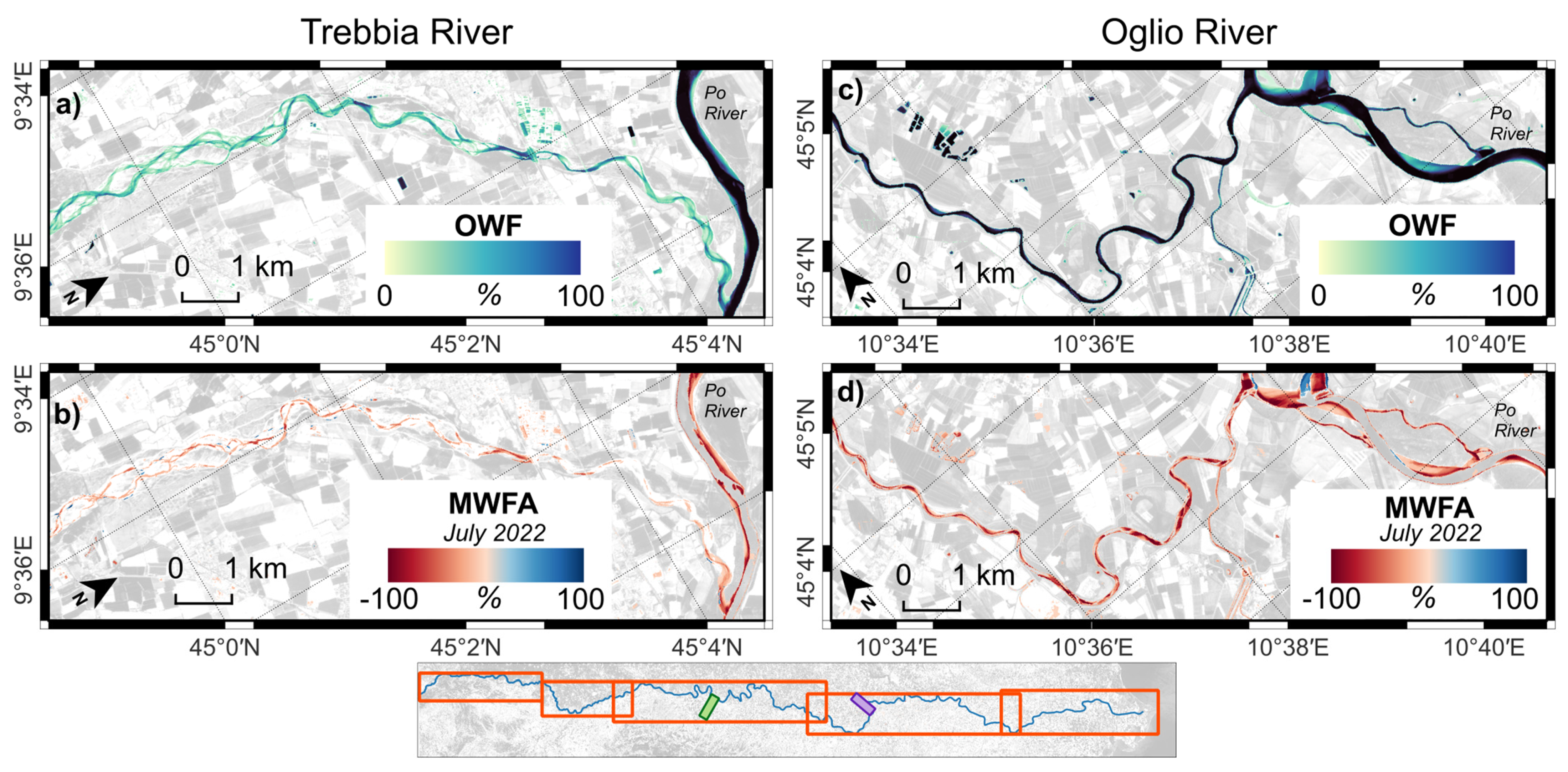
| SDI | Category |
|---|---|
| SDI ≥ 2 | Extremely wet |
| 1.5 ≤ SDI < 2 | Severely wet |
| 1 ≤ SDI < 1.5 | Moderately wet |
| 0 < SDI < 1 | Mildly wet |
| −1 ≤ SDI < 0 | Mild drought |
| −1.5 ≤ SDI < −1 | Moderate drought |
| −2 ≤ SDI < 1.5 | Severe drought |
| SDI < −2 | Extreme drought |
| Year | Number of 1 km Slices | Proportion of the Entire Study Area (%) |
|---|---|---|
| 2016 | 89 | 18.5 |
| 2017 | 66 | 13.7 |
| 2018 | 27 | 5.5 |
| 2019 | 21 | 4.3 |
| 2020 | 8 | 1.7 |
| 2021 | 32 | 6.7 |
| 2022 | 342 | 71.4 |
| 2023 | 61 | 12.7 |
Disclaimer/Publisher’s Note: The statements, opinions and data contained in all publications are solely those of the individual author(s) and contributor(s) and not of MDPI and/or the editor(s). MDPI and/or the editor(s) disclaim responsibility for any injury to people or property resulting from any ideas, methods, instructions or products referred to in the content. |
© 2025 by the authors. Licensee MDPI, Basel, Switzerland. This article is an open access article distributed under the terms and conditions of the Creative Commons Attribution (CC BY) license (https://creativecommons.org/licenses/by/4.0/).
Share and Cite
Filipponi, F.; Colazzo, G.; Vassoney, E.; Comoglio, C.; Filippa, G. Sentinel-2 Reveals Record-Breaking Po River Shrinking Due to Severe Drought in 2022. Remote Sens. 2025, 17, 1070. https://doi.org/10.3390/rs17061070
Filipponi F, Colazzo G, Vassoney E, Comoglio C, Filippa G. Sentinel-2 Reveals Record-Breaking Po River Shrinking Due to Severe Drought in 2022. Remote Sensing. 2025; 17(6):1070. https://doi.org/10.3390/rs17061070
Chicago/Turabian StyleFilipponi, Federico, Giulia Colazzo, Erica Vassoney, Claudio Comoglio, and Gianluca Filippa. 2025. "Sentinel-2 Reveals Record-Breaking Po River Shrinking Due to Severe Drought in 2022" Remote Sensing 17, no. 6: 1070. https://doi.org/10.3390/rs17061070
APA StyleFilipponi, F., Colazzo, G., Vassoney, E., Comoglio, C., & Filippa, G. (2025). Sentinel-2 Reveals Record-Breaking Po River Shrinking Due to Severe Drought in 2022. Remote Sensing, 17(6), 1070. https://doi.org/10.3390/rs17061070










